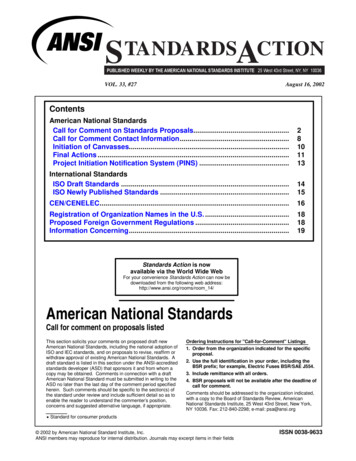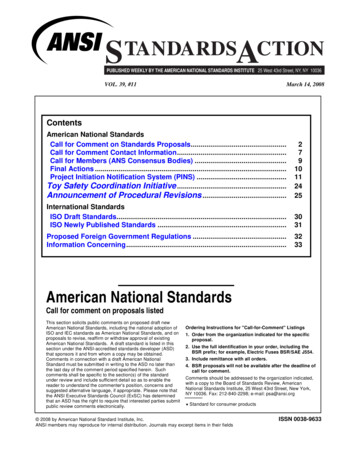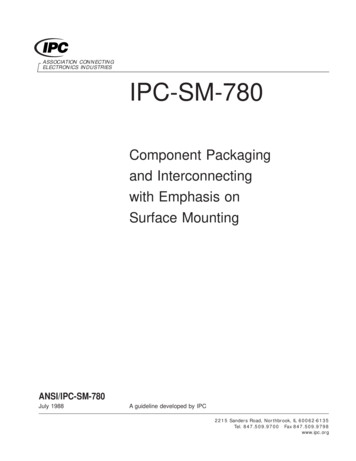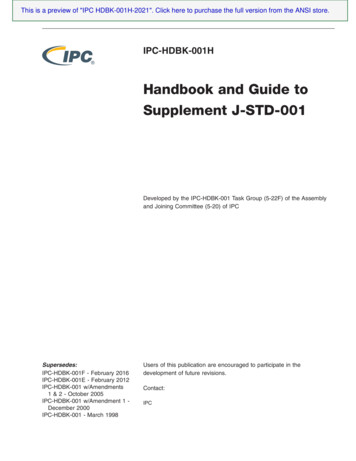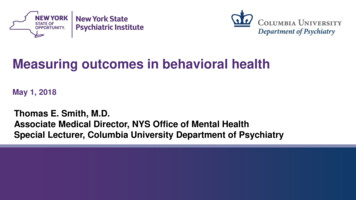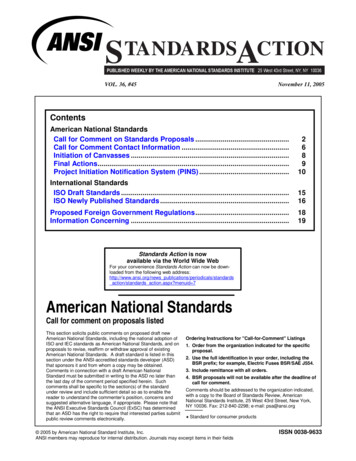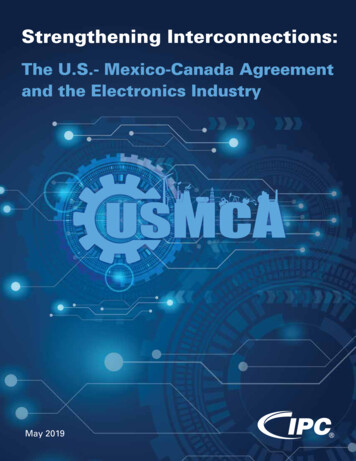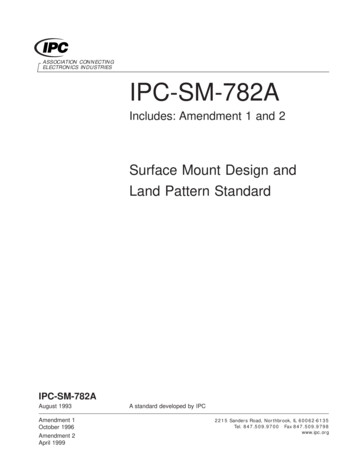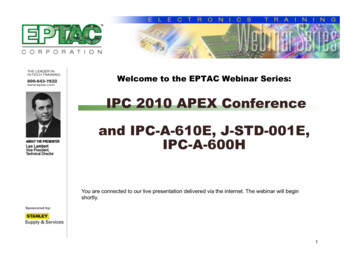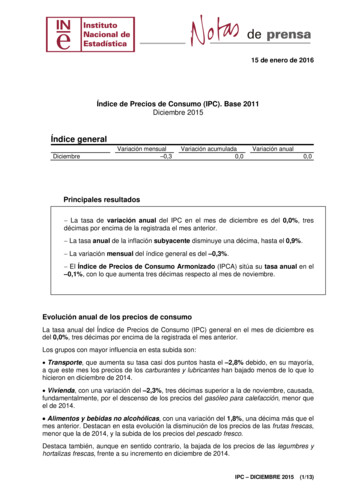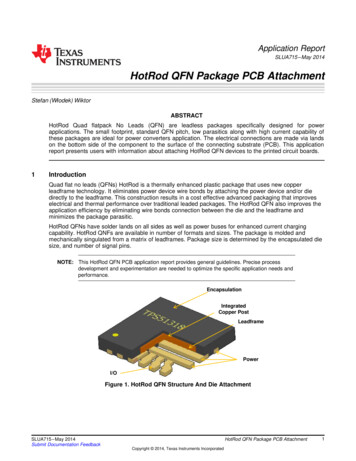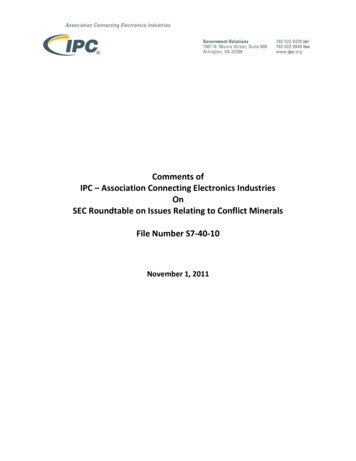
Transcription
Comments ofIPC – Association Connecting Electronics IndustriesOnSEC Roundtable on Issues Relating to Conflict MineralsFile Number S7-40-10November 1, 2011
IPC – Association Connecting Electronics IndustriesNovember 1, 2011Pg. 2Comments of IPC – Association Connecting Electronics Industries on SECRoundtable on Issues Relating to Conflict MineralsTable of ContentsI.Executive Summary . 3II.The SEC Has Significantly Underestimated the Cost of the Proposed Rule . 4III.What is Covered by the Rule . 5A. The SEC Should Specify Tin, Tantalum, Tungsten and Gold as Metals for Which the RegulatoryRequirements Must be Met . 5B.IV.The SEC Should Clearly Define Covered Products. . 6What Steps Will be Required to Comply with the Rule . 7A.The SEC Could Significantly Reduce the Burden of this Rule Through a Phased Implementation. 7B.The SEC Should Provide Non-Binding Examples of Appropriate Due Diligence . 8C.The SEC Should Specify Performance Audits Focusing on the Due Diligence Process . 9D.A Conflict Minerals Report and Audit Should Not Be Required for Recycled Materials . 9E.The SEC Should Address How to Handle Minerals from a Mine that Changes “Conflict” Status 10Reporting Issues . 10V.A.The SEC Should Develop a Synchronized Reporting Schedule . 10B.The SEC Must Provide a Transition Rule for Stockpiled Materials . 10VI.Conclusions . 11
IPC – Association Connecting Electronics IndustriesNovember 1, 2011I.Pg. 3Executive SummaryIPC – Association Connecting Electronics Industries is pleased to provide these supplementalcomments in response to the Security and Exchange Commission (SEC) proposed rule onConflict Minerals (S7-40-10) and the panel discussion held on October 18, 2011. Thesecomments focus on the issues raised during the October 18, 2011 panel discussion and includeadditional information that has become available since our original comments were submitted.IPC, a U.S. headquartered global trade association, represents all facets of the electronicinterconnect industry, including design, printed board manufacturing and electronics assembly.Printed boards and electronic assemblies are used in a variety of electronic devices that includecomputers, cell phones, pacemakers, and sophisticated missile defense systems. IPC has over2,700 member companies. As a member-driven organization and leading source for industrystandards, training, market research and public policy advocacy, IPC supports programs to meetthe needs of an estimated 1.7 trillion global electronics industry.IPC supports the underlying goal of the proposed rule that implements the measure described inSection 1502 of the Dodd-Frank Act (Public Law 111-203), which is to prevent the atrocitiesoccurring in the Democratic Republic of Congo (DRC). We understand that those perpetratingthe atrocities are obtaining funding from the minerals trade and that the aim of Section 1502 is tocut off this funding. The electronics industry, including IPC members, continues to be activelyinvolved in a number of ongoing initiatives that seek to improve control and transparency in themining and refinement of conflict minerals.These comments focus on the issues raised during the October 18, 2011 panel discussion onconflict minerals and IPC’s recommendations for reducing the significant burden imposed by theproposed regulations. These issues, and a number of other issues of concern, are discussed inmore detail in our March 2, 2011 comments.IPC believes the SEC's analysis on the impact of the regulation significantly underestimates theimpact and cost to U.S. manufacturers. A recent, independent analysis of the costs, conducted atthe Payson Center for International Development at Tulane University Law School1 estimatedthe implementation of the proposed rules would cost 7.93 billion dollars, over 100 times theSEC’s estimate of 71.2 million.IPC encourages the SEC to implement the requirements of Section 1502 in a manner thatsupports the goals of the statute without unduly burdening U.S. manufacturing industries orcausing unnecessary disruptions of the minerals trade, which is vital to the livelihood of thepeople of the DRC.1Chris Bayer, Tulane University, “A Critical Analysis of the SEC and NAM Economic Impact Models and theProposal of a 3rd Model in view of the Implementation of Section 1502of the Dodd-Frank Wall Street Reform andConsumer Protection Act, October 17, 2011.
IPC – Association Connecting Electronics IndustriesNovember 1, 2011Pg. 4Specifically, given the significant estimated burdens associated with the proposed regulations,we encourage the SEC to seriously consider the implementation of phase-in rules which cansignificantly reduce the burden of the proposed regulation while still meeting legislative intent.The SEC also must define a reasonable level of inquiry for recycled materials that does notrequire a conflict minerals report and audit.The SEC should focus the regulation on economically significant uses of conflict minerals bylimiting coverage to conflict minerals contained in the product, instituting a de-minimisthreshold, requiring a minimum level of control over the manufacturing process before an issuermust comply with the proposed rules, and specifying tin, tantalum, tungsten and gold as metalsfor which the regulatory requirements must be met. We also recommend that the SEC provide atransition rule for stockpiled materials.The SEC can also reduce the burden on issuers and their suppliers by providing non-bindingexamples of reasonable country of origin inquiries and due diligence. Both initial and ongoingburdens can also be reduced by implementing a synchronized reporting schedule and specifyingperformance audits focusing on the due diligence process.II.The SEC Has Significantly Underestimated the Cost of the Proposed RuleIPC believes the SEC's analysis on the impact of the regulation significantly underestimates theimpact and cost to U.S. manufacturers. The SEC, more specifically, has underestimated thenumber of issuers affected by the rule, failed to account for all of the derivatives regulated underthe proposed rule, underestimated the cost of compliance for affected issuers, and failed toconsider the enormous burden on the supply chain. The SEC must, as detailed in thesecomments, significantly revise their cost estimate and implement measures that would reduce theanticipated burden.The SEC has incorrectly estimated the number of issuers that will need to prepare a ConflictMetals Report (CMR). The SEC incorrectly assumes that since the DRC and adjacent countriesmay account for less than 20% of the world’s supply of tantalum and the common derivatives ofother conflict minerals, only 20% of affected issuers will be required to complete a CMR. Thisis a flawed assumption because 1) the minerals supplied by the DRC may be distributed such thatthey account for 20% of the supply for 100% of users, and 2) the vast majority of users will beunable to identify the origin of their conflict minerals, especially until more viable audit andtracking systems are in place, and therefore will need to complete a CMR. It is expected thatnearly 100% of affected issuers will need to complete a CMR, especially in the initial years ofthe regulation.The SEC has underestimated the number of issuers affected by the rule by focusing only on thefour most common derivatives of the conflict minerals identified in the legislation. As discussedin Section III.A. of these comments, we encourage the SEC to focus the regulation on tin,tantalum, tungsten and gold. Should the SEC choose to retain the broader scope of the
IPC – Association Connecting Electronics IndustriesNovember 1, 2011Pg. 5regulation, all derivatives of the regulated conflict minerals must be included in the costestimates.The SEC has underestimated the cost of compliance for issuers. A recent, independent analysisof the costs was conducted at the Payson Center for International Development at TulaneUniversity Law School2 at the request of Senator Durbin, one of the authors of the provisions inSection 1502. The study estimated issuer costs of 2.8 billion in the first year for implementingthe proposed rule, plus ongoing, recurring costs for CMR audits required under the proposedregulation. The Tulane study estimated key costs, many of which were not accounted for by theSEC. For example, strengthening internal management systems in order to support due diligencewould cost issuers 26 million dollars and instituting the necessary IT systems would cost issuers 2.6 billion dollars.The SEC failed to account for the significant burden imposed on the supply chain by theproposed regulation. The Tulane study found the costs to the supply chain to be almost doublethe direct costs borne by issuers, at 5.1 billion for the first year.III.What is Covered by the RuleA.The SEC Should Specify Tin, Tantalum, Tungsten and Gold as Metals forWhich the Regulatory Requirements Must be MetSection 1502 defines conflict minerals as “columbite-tantalite (coltan), cassiterite, gold,wolframite, or their derivatives.” Although the main metals derived from these mineralsare tin, tantalum, tungsten, and gold, a number of other metals, including niobium, iron,and uranium are refined from these minerals. The broad nature of this definition createsan unintended and significant burden on issuers and their suppliers by exponentiallyincreasing the number of metals, products, suppliers, and smelters that must be traced andaudited under the regulations. Tin, tantalum, tungsten and gold are the economicallysignificant derivatives of these metals. Other metals are neither discussed in the SEC’sproposed regulation nor are they included in the SEC’s cost estimate. Should the SECchoose not to clarify focus on these four metals, the SEC must revise its cost estimates toaccount for the significant additional costs that would be incurred by issuers and theirsupply chain. By focusing the regulation on these specific metals, the SEC will reduce theburden of the regulation without reducing their intended effectiveness.2Chris Bayer, Tulane University, “A Critical Analysis of the SEC and NAM Economic Impact Models and theProposal of a 3rd Model in view of the Implementation of Section 1502of the Dodd-Frank Wall Street Reform andConsumer Protection Act, October 17, 2011.
IPC – Association Connecting Electronics IndustriesNovember 1, 2011B.Pg. 6The SEC Should Clearly Define Covered Products.1. Necessary to the functionalityThe SEC should not consider conflict minerals necessary to the production of aproduct if they are not contained in the product. The SEC should not considerconflict minerals necessary to the production of a product even if the tool or machinecontaining conflict minerals was manufactured for the purpose of producing theproduct. Such an approach would be much broader than intended by the legislation.Additionally, such an approach would be very difficult for the SEC to implement orenforce, given the difficulty of determining and verifying which equipment isdesigned for what production process. Finally, this reporting may be unnecessarilyduplicative, as any issuer manufacturing tools or machinery would be required tocomply with the proposal if conflict minerals are necessary for the functionality ofthe tool or machine.2. De-minimisAs discussed in more detail in our March 2, 2011 comments, IPC recommends thatthe SEC adopt 0.1% by weight de-minimis threshold in their rule. A de-minimisstandard is not a loophole or exemption and it will not decrease efforts to increasesupply chain transparency. A de-minimis threshold will allow the SEC and issuers tofocus on the products containing a significant amount of the conflict minerals in amanner that will change supply chain behavior. Should the SEC not wish toimplement permanent de minimis standards, we recommend the use of de minimisstandards for phasing-in the regulation. By focusing only on significant uses ofconflict minerals first, the SEC would improve the efficiency of implementation andease the compliance burden on some of the less significant users of conflict minerals,while maintaining consistency with the intent and goals of the rules.3. Control over the productThe SEC should require a minimum level of influence, involvement, or control overthe manufacturing process before an issuer must comply with the proposed rule.Electronics Manufacturing Service (EMS) or contract manufacturers assembleelectronics for Original Equipment Manufacturers (OEMs) or name brands. In manycases the OEM specifies all parts in the product through an Approved Supplier List(ASL). Although many of these items contain conflict minerals, the EMS providertypically does not control selection of suppliers or materials sources. Further, thismay put the EMS provider where they do not have sufficient leverage over a supplierselected by an OEM, placing an excessive burden on the EMS provider. Issuers whopurchase or assemble products from an ASL controlled by their customers should beexempted from the proposed reporting requirements for those items they do notspecify.
IPC – Association Connecting Electronics IndustriesNovember 1, 2011Pg. 74. Reasonable country of origin inquiryIPC encourages the SEC to provide non-binding guidance as to what wouldconstitute a reasonable country of origin inquiry standard. In order to promote costeffective implementation, the SEC permits and encourages issuers to rely onreasonably reliable representations from their suppliers. Given the complex nature ofthe electronics and other manufacturing supply chains it would be extraordinarilyinefficient if each member of the supply chain were required to attempt to trace theconflict minerals in their products to the smelter, or even less practically, to the mine.If issuers are not able to rely on reasonably reliable representations from theirprocessing facilities, both directly or indirectly, the burden of this regulation will besignificantly increased.IV.What Steps Will be Required to Comply with the RuleA.The SEC Could Significantly Reduce the Burden of this Rule Through aPhased Implementation.As discussed in our March 2, 2011 comments, IPC strongly supports a phasedimplementation of the conflict minerals regulation to better align regulatory requirementswith developing traceability and transparency systems. It is highly unlikely that a fullscale-up of these programs will be possible in time to allow issuers to rely upon them inthe year immediately following implementation of the regulation.In order to avoid imposing a de-facto ban on legitimate minerals trade from the DRC andadjacent countries, we recommend that the SEC establish a transitional category ofconflict minerals of indeterminate source. Provision of this third category for classifyingconflict minerals should be of a short and temporary nature according to a schedule thatwill allow enough time for implementation of supply chain traceability in the DRC andadjacent countries.As discussed in our previous comments, industry-developed on-the-ground tracking andsmelter audit systems will play a critical role in the ability of the supply chain to identifyconflict minerals that are DRC conflict free. Once traceable conflict free conflict mineralsare available to the smelters in the next six to twelve months, it will take approximatelyone year for these minerals to be smelted and move through the supply chain forincorporation into components of complex, finished products. For these reasons, IPC isproposing a three year phase-in of these rules based upon the anticipated dates at whichon-the-ground tracking systems are in place and supplying verifiable “conflict-free”minerals and a significant number of smelters have been audited and their productsvalidated as “DRC conflict free.”During the phase-in period, we recommend that issuers be required to disclose to theSEC: 1) that specific conflict minerals are necessary to the functionality of a product
IPC – Association Connecting Electronics IndustriesNovember 1, 2011Pg. 8manufactured by the issuer; 2) the company’s conflict minerals policy; 3) the company’sefforts to exercise due diligence on the conflict minerals used in their product. Werecommend that during this phase-in period, companies that are unable to determine thesource of their conflict minerals would not be required to complete a CMR, as thelegislation requires such a measure only for companies whose conflict minerals didoriginate in the DRC or adjacent countries. Implementation of this phase-in wouldprovide for an orderly, cost-efficient transition that promotes the goals of the legislationwithout inflicting undue burdens and harm upon U.S. issuers, their suppliers, and thoseengaged in the legitimate trade of conflict minerals from the DRC.Failure to establish a realistic, implementable time-line for required supply chaintransparency will result in continuing significant, negative unintended consequences forthose engaged in legitimate minerals trade. As it will be impossible to implementmeasures to provide chain of custody from all conflict mines to smelters in the next oneto three years, many companies will impose a de-facto ban on minerals originating in theDRC. This will impose significant financial hardship to thousands that depend on thelegitimate minerals trade for their livelihoods.B.The SEC Should Provide Non-Binding Examples of Appropriate DueDiligenceGiven the varying circumstances affecting the broad range of issuers impacted by thisrule, the SEC should not prescribe specific due diligence requirements. Prescribing orotherwise specifying required due diligence would impose significant burdens on issuers,especially those that are small businesses. The SEC should, however, provide assistanceto issuers by identifying examples of acceptable due diligence such as industry developedsmelter validation audits, the bag and tag scheme being developed by ITRI, informationor standards provided by the Department of State or other federal agencies, the OECDstandards, and others. Provision of a list of acceptable standards and guidance willprovide important assistance to issuers without hampering their ability to comply in amanner that is both efficient and appropriate for their circumstances.It is extremely important that the regulation permits and encourages issuers to rely onreasonably reliable representations of smelters or any other actor in the supply chain byexplicitly supporting the acceptability of supply chain approaches to due diligence. Asmentioned previously, it would be extraordinarily inefficient if not impossible for eachmember of the supply chain to attempt to independently research and verify all the wayback to the mine of origin for the conflict minerals contained in their product. If issuersare not able to rely on reasonably reliable representations from their supply chain, theburden of this regulation will be significantly increased.
IPC – Association Connecting Electronics IndustriesNovember 1, 2011C.Pg. 9The SEC Should Specify Performance Audits Focusing on the Due DiligenceProcessThird party audits are likely to be one of the most costly ongoing aspects of compliancewith individual audits expected to cost 25,000.3 SEC actions to clearly define auditrequirements could have significant bearing on the costs of complying with thisregulation.Third party audits should focus on the design of a due diligence process rather than thecontents of a CMR. The audit should examine a company’s due diligence complianceprogram and procedures, for example, rather than a materials-based outcome approachverifying whether the company was able to trace the minerals in its products back to thesmelter. We believe that this type of audit is more logically conducted under theGovernment Accountability Office standards for a performance audit which is generallyused for non-financial audits and need not be conducted by an accounting professional.We believe that allowing performance of these audits by a non-financial expert is likelyto result in less costly audits and improve the quality of the audits by permitting them tobe conducted by auditors with experience in more pertinent fields such as supply chainlogistics, corporate management, and social responsibility.D.A Conflict Minerals Report and Audit Should Not Be Required for RecycledMaterialsAs detailed in our March 2, 2011 comments, IPC recommends that the SEC not requireissuers using conflict minerals from recycled or scrap sources to furnish a CMR,including a certified independent private sector audit. Instead, the final rule shouldinclude an alternative approach for recycled or scrap sources that is practicable and doesnot overly burden recycled materials so as to discourage their use. Given othergovernment efforts to encourage recycling in electronics and other industries, it isimperative that the SEC does not diminish these efforts by adding significant regulatoryburdens to the use of recycled or reclaimed conflict minerals.An issuer using a recycled material containing conflict minerals will not be able toprovide any of the details required in a CMR. The traceability of the reclaimed metals isimpossible to track due to the various forms of recycling and thousands of consolidators,reclaimers, and scrap dealers both foreign and domestic. Instead, issuers should have areasonable basis for believing the material is recycled and maintain auditable records tosupport the determination. IPC believes that due diligence is the appropriate requirementfor verifying recycled or reclaimed conflict minerals.We believe recycled conflict minerals should have parity with conflict mineralsoriginating from a conflict-free mine so as to encourage manufacturers to use recycled3Chris Bayer, Tulane University, “A Critical Analysis of the SEC and NAM Economic Impact Models and theProposal of a 3rd Model in view of the Implementation of Section 1502of the Dodd-Frank Wall Street Reform andConsumer Protection Act, October 17, 2011.
IPC – Association Connecting Electronics IndustriesNovember 1, 2011Pg. 10and scrap materials, to reduce the demand for minerals that would support armed groupsin the DRC and adjoining countries, and to maintain a fair market for metals andminerals. This could be accomplished by providing that after a manufacturer conducts areasonable inquiry into the source of its conflict minerals no further action is required ifeither: (1) the minerals were determined to originate not from the DRC or adjoiningcountries, or (2) the minerals originated from a scrap or recycled source.E.The SEC Should Address How to Handle Minerals from a Mine thatChanges “Conflict” StatusAdditionally, regulations will be needed to address minerals from a mine that changesstatus from “non-conflict” to “conflict.”The State Department has recognized proper identification of mines that are controlled byparties perpetrating atrocities to be a significant challenge. From the extraction of theminerals from the mines to the incorporation of the refined metals into productsmanufactured in the United States, significant time will pass and “conflict mines” willlikely change status. For this reason, a no-transubstantiation rule is recommended.We encourage the SEC to adopt a no-transubstantiation rule stating that if a mineral is“conflict-free” when it arrives at the smelter, it cannot become “conflict-associated” if itsmine of origin changes status during the period that the mineral/refined metal is movingthrough the supply chain.The State Department has recognized proper identification of mines that are controlled byparties perpetrating atrocities to be a significant challenge. From the extraction of theminerals from the mines to the incorporation of the refined metals into productsmanufactured in the United States, significant time will pass and “conflict mines” willlikely change status. For this reason, a no-transubstantiation rule is recommended.V.Reporting IssuesA.The SEC Should Develop a Synchronized Reporting ScheduleThe SEC can significantly reduce the substantial burden on the supply chain bypromulgating a single reporting date for all issuers. Requiring reports throughout theyear, in concert with each issuer’s annual report will pose a significant burden on thesupply chain. Because a supplier’s multiple customers will be on a different reportingschedule, the supplier will likely have to conduct due diligence and support third partyaudits repeatedly throughout the year. A single reporting date will allow for increasedefficiency and thus lower costs, without reducing the effectiveness of the regulations.B.The SEC Must Provide a Transition Rule for Stockpiled Materials
IPC – Association Connecting Electronics IndustriesNovember 1, 2011Pg. 11In order to make the reporting requirements useful and practicable, it is necessary for theSEC to implement transition rules to address aboveground minerals stocks alreadypresent in the supply chain when the regulation is implemented. Similarly, productsmanufactured with the refined metals already incorporated in finished goods or fromconflict minerals already in the suppliers’ inventories prior to an establishedimplementation date should be exempt. Additionally, regulations will be needed toaddress minerals from a mine that changes status from “non-conflict” to “conflict.”Without transition rules, it will be nearly impossible for users of conflict minerals to beable to identify themselves as “conflict-free,” until the regulation has been in place for anumber of years and all stocks existing prior to the implementation of the regulation havebeen used. Failure to implement transition rules will render the initial years of theregulation virtually meaningless.VI.ConclusionsIPC is committed to addressing the use of conflict minerals and is actively working withmany of its members on both a domestic and international level to address the issue. IPCmember companies are participating in a variety of sector specific initiatives to developindustry wide protocols for removing conflict minerals from supply chains as well aswith international organizations. Given the broad potential impact of this regulation onthe day-to-day operations of manufacturing companies throughout the United States, andthe impacts on legitimate trade in the DRC, we urge the SEC to exercise caution whenimplementing regulations under Section 1502 of the Dodd-Frank Act. Specifically, weencourage the SEC to: Allow maximum time and flexibility for industry to implement these potentiallyfar-reaching rules;Implement phase-in rules which can significantly reduce the burden of theproposed regulation while still meeting legislative intent;Allow companies the flexibility to develop appropriate, supply-chain-based duediligence processes by providing non-binding examples of a reasonable country oforigin inquiries and due diligence;Implement a synchronized reporting schedule;Specify performance audits focusing on the due diligence process;Specify tin, tantalum, tungsten and gold as metals for which the regulatoryrequirements must be met;Define a reasonable level of inquiry for recycled materials that does not require aconflict minerals report and audit;
IPC – Association Connecting Electronics IndustriesNovember 1, 2011 Pg. 12Develop appropriate transition rules for materials already in the manufacturingsupply chain at the time these regulations are implemented;Focus the regulation on economically significant uses of conflict minerals bylimiting coverage to conflict minerals contained in the product, instituting a deminimis threshold, and requiring a minimum level of control over themanufacturing process before an issuer must comply with the proposed rules; andProvide a transition rule for stockpiled materials.Implementation of these recommendations will significantly reduce the substantialburden posed by the proposed regulations with undermining the goals of the legislation.We look forward to continuing to work with the SEC. Please contact me should youhave any questions.Fern AbramsDirector of Government Relations and Environmental Policy
IPC, a U.S. headquartered global trade association, represents all facets of the electronic interconnect industry, including design, printed board manufacturing and electronics assembly. Printed boards and electronic assemblies are used in a variety of electronic devices that include
